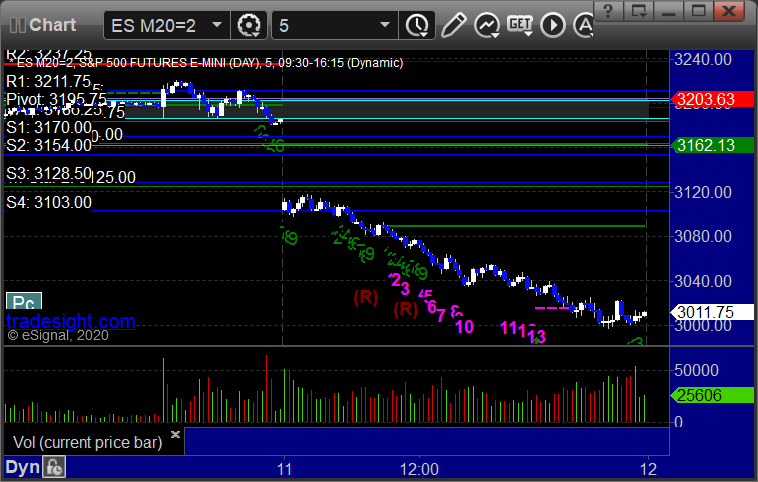Futures Calls Recap for 6/15/20
The markets gapped down and then rallied all day on 4.4 billion NASDAQ shares.
Net ticks: +6 ticks.
As usual, let's start by taking a look at the ES and NQ with our market directional lines, VWAP, and Comber on the 5-minute chart from today's session:
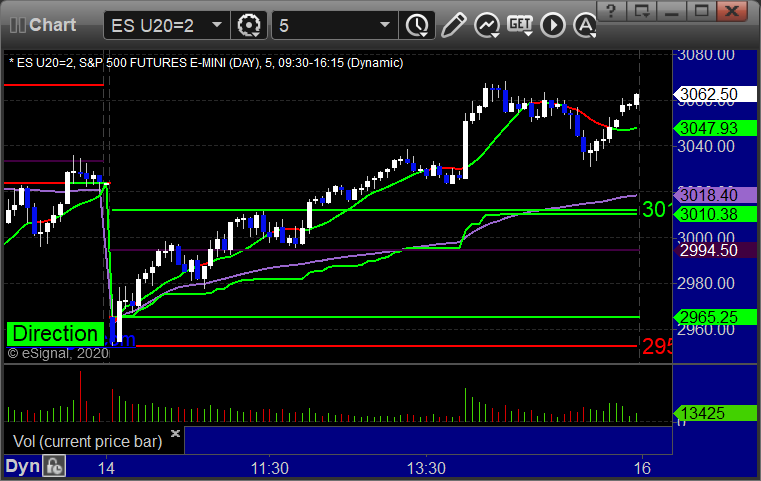
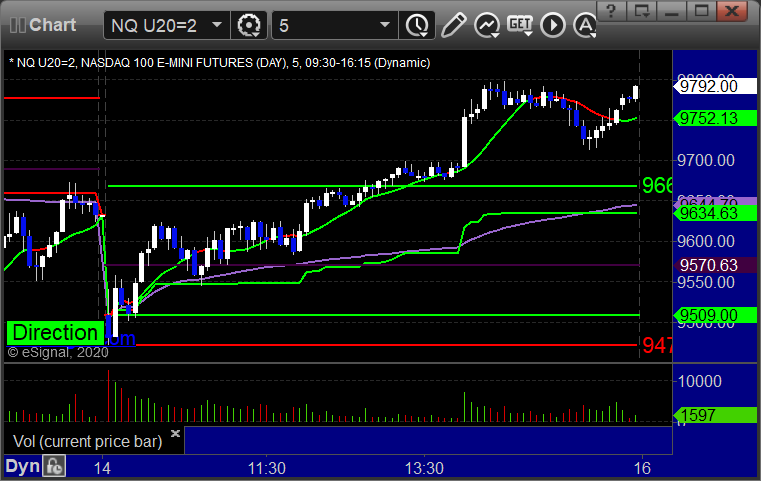
ES and NQ Opening and Institutional Range Plays:
ES Opening Range Play triggered short at A and worked, triggered long at B but too far out of range to take:
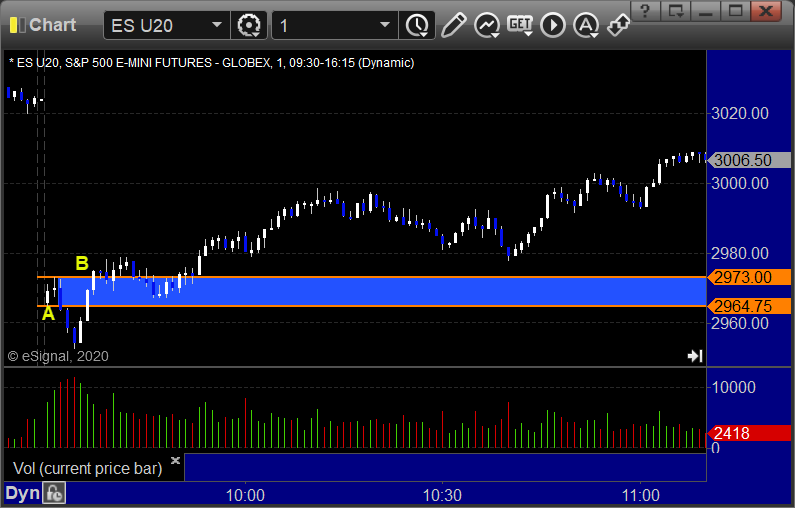
NQ Opening Range Play triggered both ways but too far out of range to take:
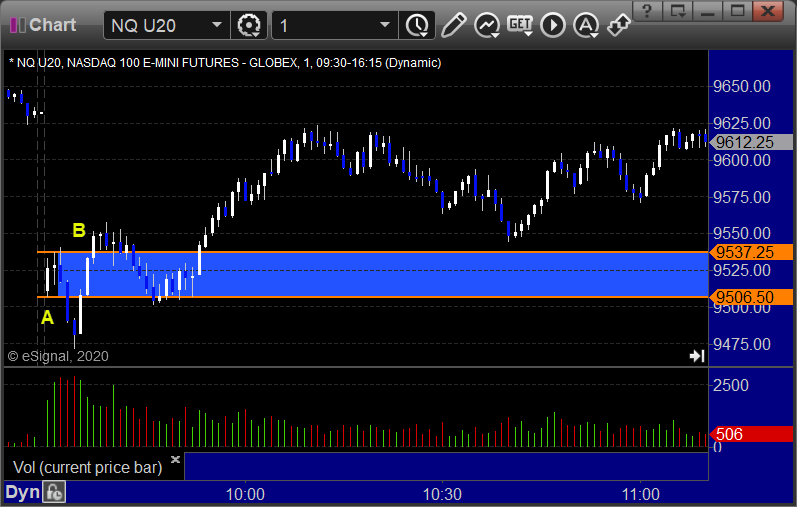
ES Tradesight Institutional Range Play:
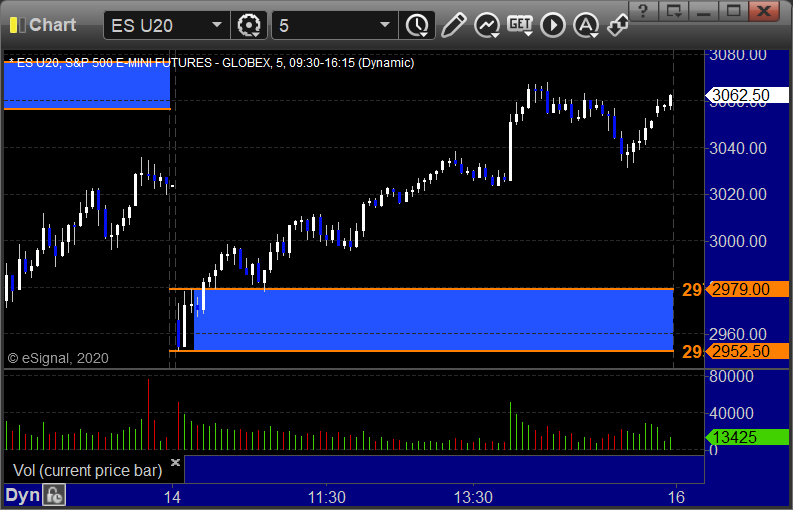
NQ Tradesight Institutional Range Play:
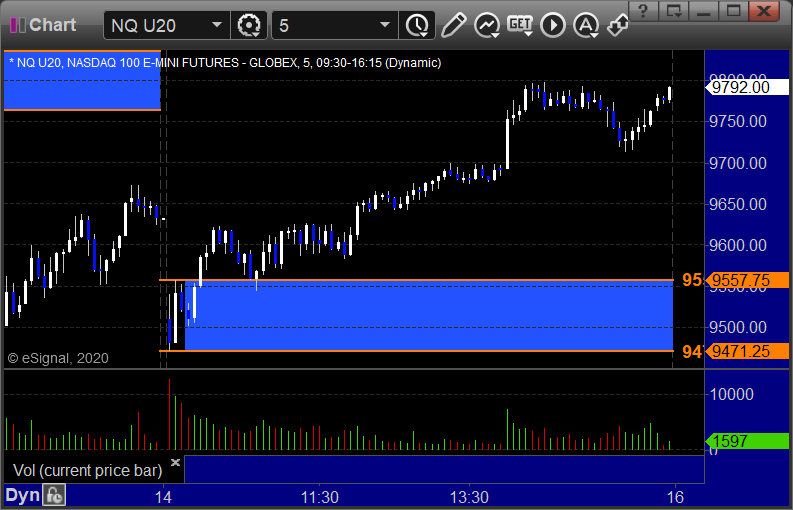
ES:
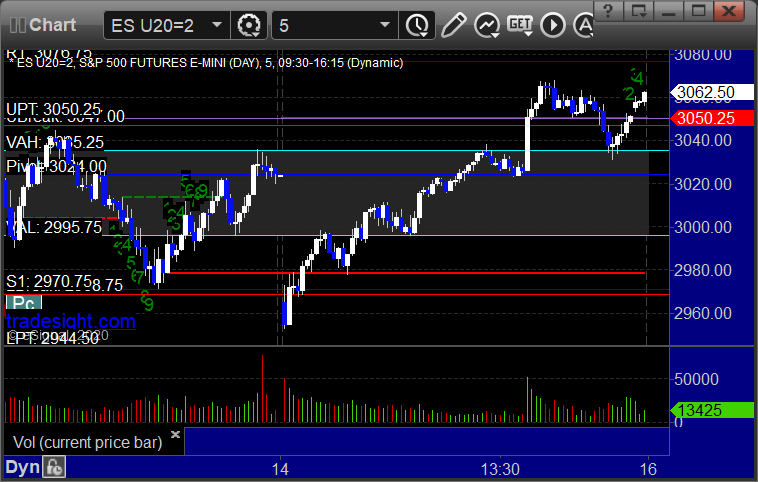
Forex Calls Recap for 6/15/20
Two stop outs and a winner that is still going to start the week. See EURUSD and GBPUSD sections below.
Here's a look at the US Dollar Index intraday with our market directional lines:
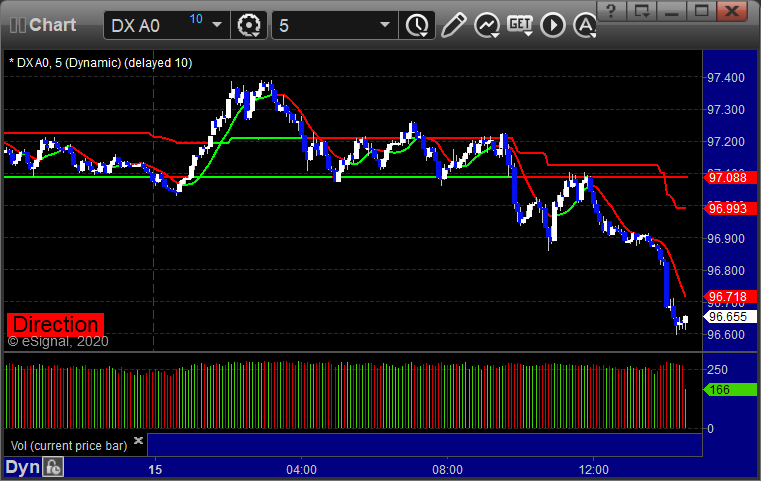
EURUSD:
Triggered long at A and stopped. Woke up in the morning and said to re-enter. Triggered long at B, hit first target at C, still holding second half with a stop under D:
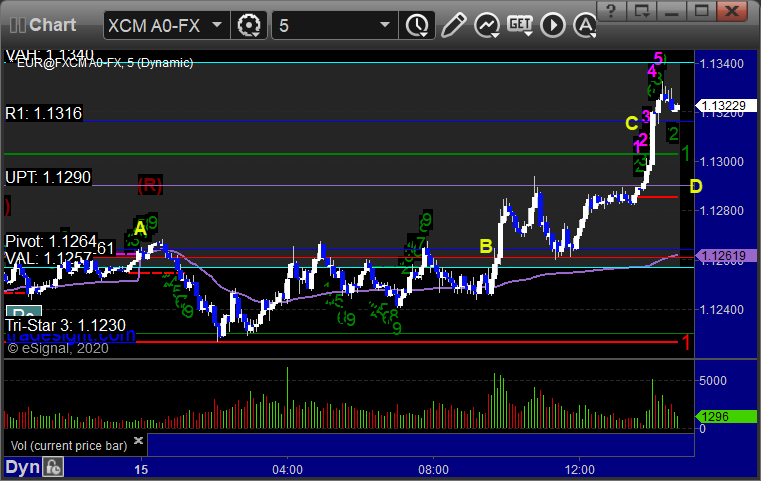
GBPUSD:
Triggered short at A and stopped:
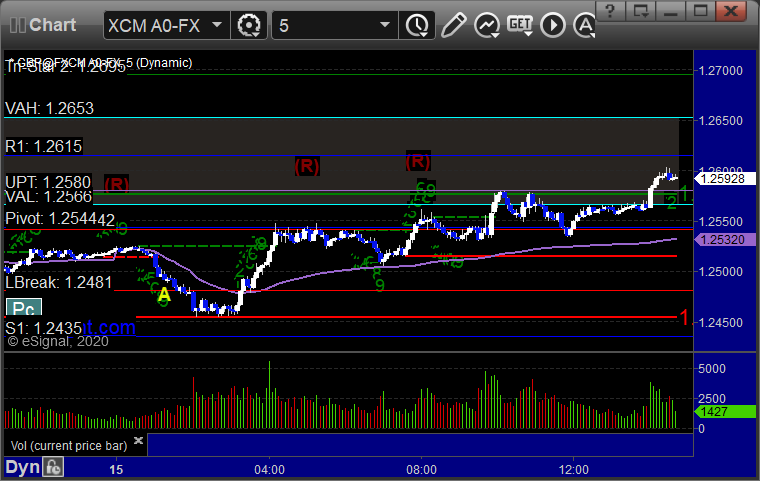
Tradesight May 2020 Stock Results
Tradesight has been providing stock calls daily since 2002. We post the results of our of our trades, winners and losers, in our reports and Market Blog every day. Some people might find it surprising to learn that while we track our Futures and Forex formal trade call results monthly, we don’t post anything beyond the trade reviews on our Stocks calls.
There is actually a very specific reason for this. I’ve never been a fan of trying to “hype” or “promote” something. Being profitable in trading is about learning what to do and getting yourself to make the right decisions. In Futures as well as in Forex, if we publish a call in advance, just about everyone should get the same fills and be able to get in and out at almost the same numbers. That isn’t always the case in stocks. It depends on how many shares you are trading and what the liquidity in the market for that stock is at the time. For that reason, I have already been hesitant to say “These are the exact results.” I would never want to try to suggest that someone would make a certain amount of dollars trading a certain number of shares or make a certain percentage. If I take a trade and sell it for a $0.30 gain, it makes a big statistical difference if someone else had to pay $0.05 more to get in and maybe got out for $0.02 less. That’s $0.23 instead of $0.30 even though the concept of the trade was fine.
However, after many requests, in October 2015, we started posting our results. You can see these monthly here.
In our system, you can basically break trades down into four categories: Big losers, small losers, small winners, and big winners.
In order to have any chance of succeeding in the markets, you have to have a system. There is no other way around it. I’ve been trading for 20 years now, and I’ve trained over 1000 people. You don’t make money if you don’t have a technically valid system for entry and exits.
Of the four categories of trades listed above, we simply don’t allow any of the first category, which is big losers. We always have a worst-case stop and we always stick to it. There should never be a scenario where you are still in a trade that is causing a significant loss if you follow our rules.
In terms of the other three categories, generally speaking, if you have about a third of your trades fall into each category, you should be making good money. In other words, if we have about 33% of our trades as small losers and 33% of trades as small winners, those basically would offset. That leaves the other 33% of so only as bigger winners, and that’s what we are here for. In our world, we count a loser as a trade that stops out (stops in our system are based on the price-level of the stock). We count a small winner as a trade that goes enough to make a partial and then either stops the second half of the trade under the entry or stops the second half of the trade slightly in the money, but no more than the partial was or so. Then the big winners are anything that keeps going beyond the partial.
So these were the results for April, which you can view here.
Tradesight Stock Results for April 2020
Number of trade calls that triggered with market support: 54
Number (and percent of total) of small losers: 14 (26%)
Number (and percent of total) of small winners: 16 (29.2%)
Number (and percent of total) of big winners: 24 (44.4%)
And for May?
Tradesight Stock Results for May 2020
Number of trade calls that triggered with market support: 40
Number (and percent of total) of small losers: 7 (20%)
Number (and percent of total) of small winners: 14 (40%)
Number (and percent of total) of big winners: 14 (40%)
An interesting month. The markets slowed down quite a bit and there were many days where there wasn't much to be done. We had less triggers, but our overall win ratio went up to 80%, so it can only be viewed as a success. What was interesting to see is how few trades triggered "without market support." Only like 3 the whole month.
Tradesight May 2020 Futures Results
Before we get to May's numbers, here is a short reminder of the results from April. The full report from April can be found here. You can also go back indefinitely by clicking here and scrolling down.
Tradesight Tick Results for April 2020
Number of trades: 10
Number of losers: 3
Winning percentage: 70%
Net ticks: +29.5 ticks
Reminder: Here are the rules.
1) Totals for the month are based on trades that occurred on trading days in the calendar month.
2) Trades are based on the calls in the Twitter feed exactly as we call them and manage them as well as the Opening Range plays under the basic strategy we teach for those in our course. We do not count everything you could have done from taking our courses and using our tools.
3) All trades are broken into two pieces, with the assumption that one half is sold at the first target and one half is sold at the final exit. These are then averaged. So if we made 6 ticks on one half and 12 on the second, that’s a 9-tick winner.
4) Pure losers (trades that just stop out) are considered 7 tick losers. We don’t risk more than that in the Twitter calls.
It is important to note that these results do not include the Tradesight Value Area or Institutional Range plays, all of which have been working quite well on their own.
You can go through the reports and compare the breakdown that I give as each trade is reviewed.
Tradesight Tick Results for May 2020
Number of trades: 17
Number of losers: 4
Winning percentage: 76.5%
Net ticks: +44.5 ticks
You can see as the market settles down that we start to get more Opening Range plays again. Soon, that should be back to normal. Meanwhile, the Value Areas worked several times, most of which aren't included here. Decent month overall, no real complaints other than we want things to get back to normal early ranges.
Tradesight May 2020 Forex Results
Before we get to the May numbers, here is a short reminder of the results from April. The full report from April can be found here and you can get the last several months in a row vertically by clicking here and scrolling down.
Tradesight Pip Results for April 2020
Number of trades: 19
Number of losers: 6
Winning percentage: 68.4%
Worst losing streak: 2 in a row
Net pips: +240 pips
Reminder: Here are the rules.
1) Calls made in the calendar month count. In other words, a call made on August 31 that triggered the morning of September 1 is not part of September. Calls made on Thursday, September 30 that triggered between then and the morning of October 1 ARE part of September.
2) Trades that triggered before 8 pm EST / 5 pm PST (i.e. pre Asia) and NEVER gave you a chance to re-enter are NOT counted. Everything else is counted equally.
3) All trades are broken into two pieces, with the assumption that one half is sold at the first target and one half is sold at the final exit. These are then averaged. So if we made 40 pips on one half and 60 on the second, that’s a 50-pip winner. If we made 40 pips on one half, never adjusted our stop, and the second half stopped for the 25 pip loser, then that’s a 7 pip winner (15 divided by 2 is 7.5, and I rounded down).
4) Pure losers (trades that just stop out) are considered 25 pip losers. In some cases, this can be a few more or a few less, but it should average right in there, so instead of making it complicated, I count them as 25 pips.
5) Trade re-entries are valid if a trade stops except between 3 am EST and 9 am EST (when I’m sleeping). So in other words, even if you are awake in those hours and you could have re-entered, I’m only counting things that I would have done. This is important because otherwise the implication is that you need to be awake 24/6. Triggers that occur right on the Big Three news announcements each month don’t count as you shouldn’t have orders in that close at that time.
You can go through the reports and compare the breakdown that I give as each trade is reviewed.
Tradesight Pip Results for May 2020
Number of trades: 22
Number of losers: 9
Winning percentage: 59.0%
Worst losing streak: 3 in a row
Net pips: +270 pips
The first two weeks of May were not very good. Then things picked up quite a bit and we had some multi-day winners that put us deep in the green once again. While I hope this continues, we do tend to see Forex slow down, especially in July and August.
Stock Picks Recap for 6/12/20
With each stock's recap, we will include a (with market support) or (without market support) tag, designating whether the trade triggered with or without market directional support at the time. Anything in the first five minutes will be considered WITHOUT market support because market direction cannot be determined that early. ETF calls do not require market support, and are thus either winners or losers.
From the report, nothing triggered.
From the Messenger/Tradesight_st Twitter Feed, Rich's BIIB triggered short (with market support) and worked:
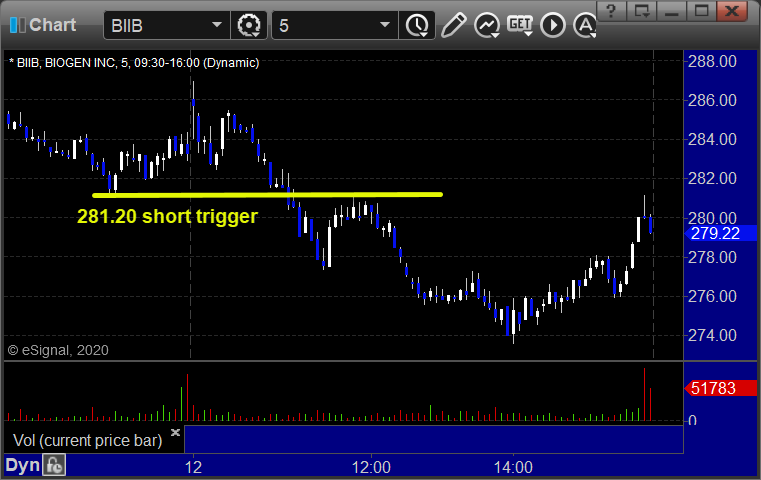
BIDU triggered short (with market support) and didn't work:
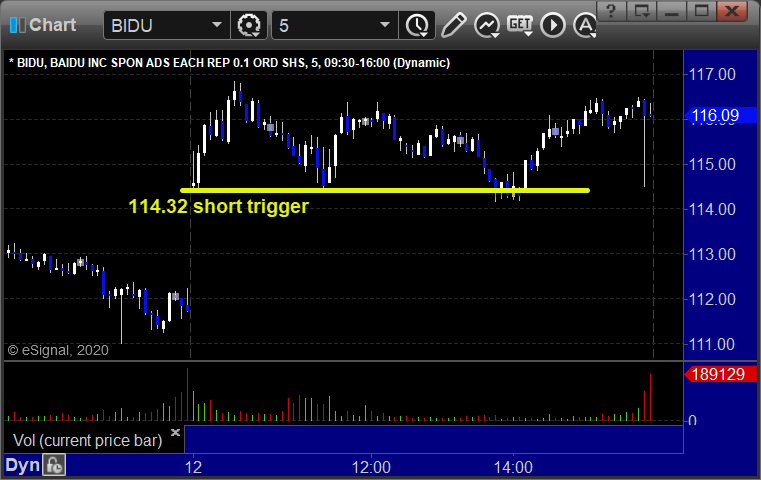
Rich's CMG triggered short (with market support) and worked:
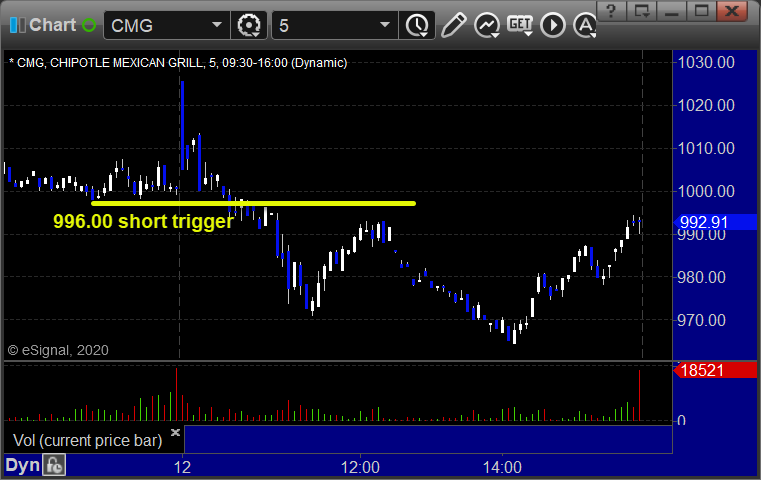
His GS triggered short (with market support) and worked enough for a partial:

In total, that's 4 trades triggering with market support, 3 of them worked, 1 did not.
Futures Calls Recap for 6/12/20
The markets gapped up and sold off most of the day, then recovered to the VWAP midday on 4.3 billion NASDAQ shares.
Net ticks: +181 ticks.
As usual, let's start by taking a look at the ES and NQ with our market directional lines, VWAP, and Comber on the 5-minute chart from today's session:


ES and NQ Opening and Institutional Range Plays:
ES Opening Range Play triggered short at A but too far out of range to take, triggered long at B and worked:

NQ Opening Range Play triggered long at A but too far out of range to take:

ES Tradesight Institutional Range Play:

NQ Tradesight Institutional Range Play:

ES:
Triggered short at A, hit first target at B, closed final piece at 3010.25 at C:
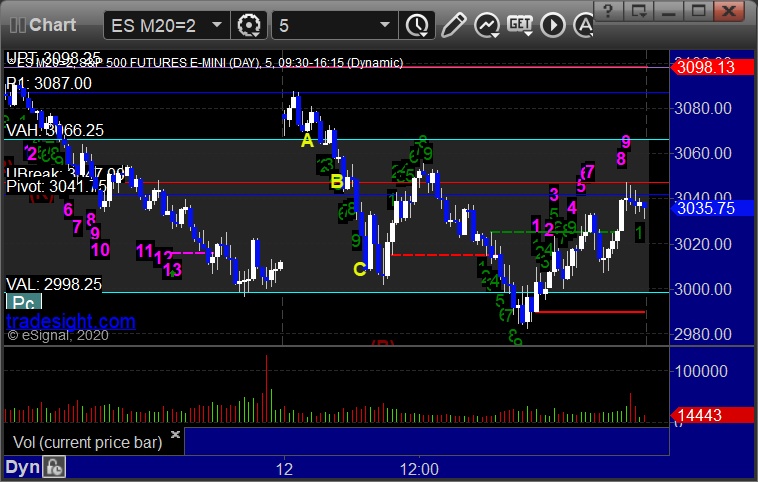
Forex Calls Recap for 6/12/20
A winner and a loser for the session. See GBPUSD section below.
Here's a look at the US Dollar Index intraday with our market directional lines:
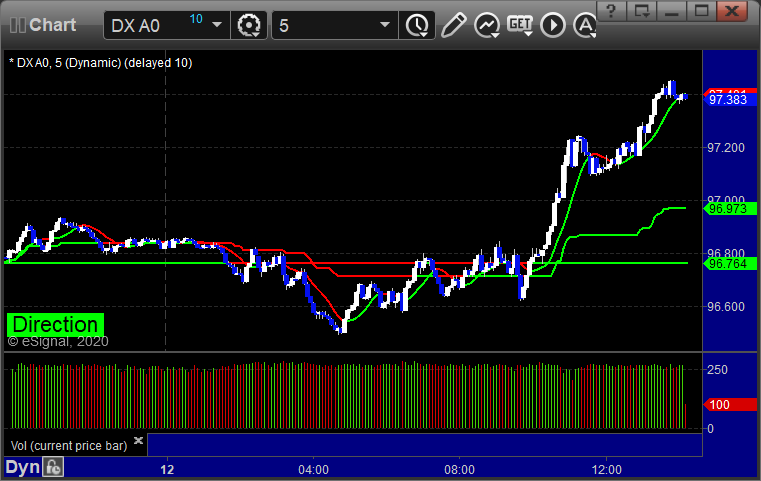
As usual on the Sunday report, we will look at the action from Thursday night/Friday, then look at the daily charts of all the pairs with the Seeker and Comber separately for the week ahead, and then glance at the US Dollar Index.
GBPUSD:
Triggered short at A and stopped. Triggered long at B, hit first target at C, stopped second half:
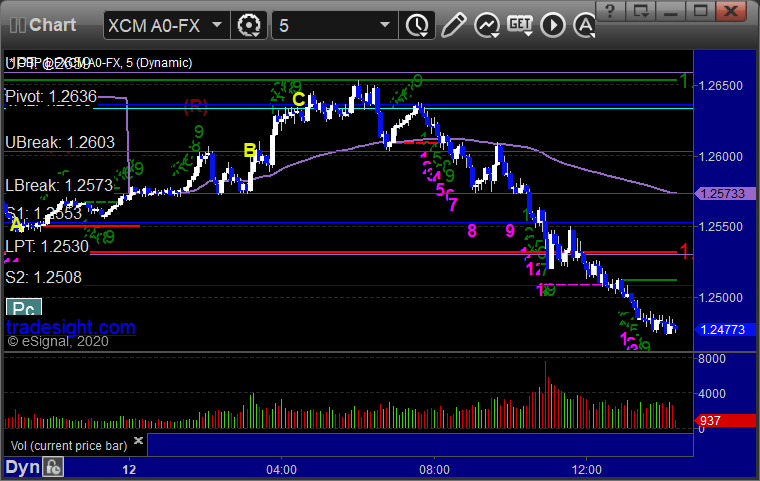
Stock Picks Recap for 6/11/20
With each stock's recap, we will include a (with market support) or (without market support) tag, designating whether the trade triggered with or without market directional support at the time. Anything in the first five minutes will be considered WITHOUT market support because market direction cannot be determined that early. ETF calls do not require market support, and are thus either winners or losers.
From the report, nothing triggered.
From the Messenger/Tradesight_st Twitter Feed, COST triggered short (with market support) and worked:
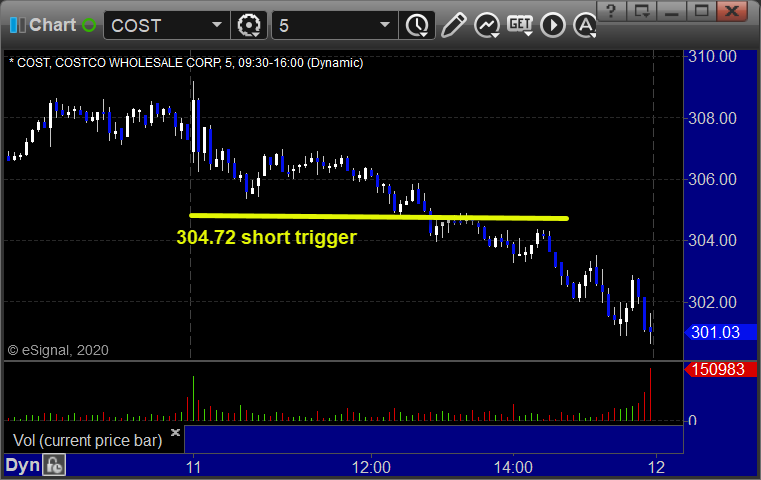
BIIB triggered short (with market support) and worked:

Rich's BKNG triggered short (with market support) and worked:
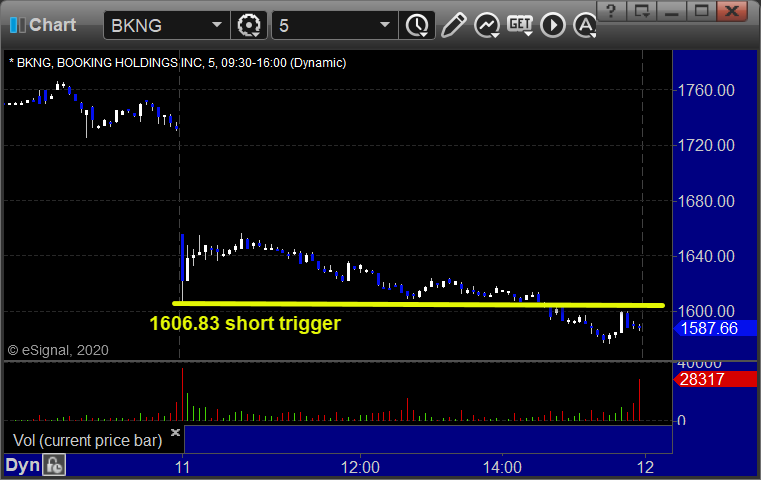
In total, that's 3 trades triggering with market support, all of them worked.
Futures Calls Recap for 6/11/20
The markets gapped down and went lower. Big day for our stock service, but we gapped past most of the futures levels on 5.5 billion shares.
Net ticks: +0 ticks.
As usual, let's start by taking a look at the ES and NQ with our market directional lines, VWAP, and Comber on the 5-minute chart from today's session:


ES and NQ Opening and Institutional Range Plays:
ES Opening Range Play triggered short at A and long at B, but too far out of range to take:

NQ Opening Range Play, nothing:

ES Tradesight Institutional Range Play:

NQ Tradesight Institutional Range Play:

ES:
